Deck 13: Polynomial and Synthetic Division
Question
Question
Question
Question
Question
Question
Question
Question
Question
Question
Question
Question
Question
Question
Question
Question
Question
Question
Question
Question
Question
Question
Question
Question
Question
Question
Question
Question
Question
Question
Question
Question
Question
Question
Question
Question
Question
Question
Question
Question
Question
Question
Question
Question
Question
Question
Question
Question
Question
Question
Question
Question
Question
Question
Question
Question
Question
Question
Question
Question
Question
Question
Question
Question
Question
Question
Question
Question
Question
Question
Question
Question
Question
Question
Question
Question

Unlock Deck
Sign up to unlock the cards in this deck!
Unlock Deck
Unlock Deck
1/76
Play
Full screen (f)
Deck 13: Polynomial and Synthetic Division
1
Use synthetic division to divide.
A)
B)
C)
D)
E)
A)
B)
C)
D)
E)
2
Use long division to divide.
A)
B)
C)
D)
E)
A)
B)
C)
D)
E)
3
Use long division to divide.
A)
B)
C)
D)
E)
A)
B)
C)
D)
E)
4
The amounts A (in billions of dollars)donated to support higher education in the United States from 2000 through 2007 are shown in the table,where t represents the year,with t = 0 corresponding to 2000.
Use a graphing utility to select a correct a scatter plot of the above data.
A)
B)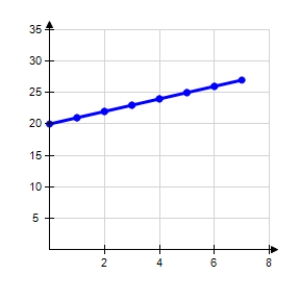
C)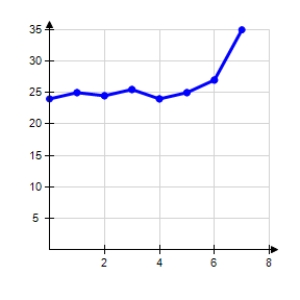
D)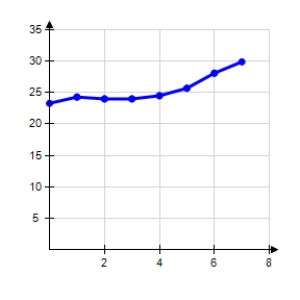
E)
Use a graphing utility to select a correct a scatter plot of the above data.
A)

B)

C)

D)

E)


Unlock Deck
Unlock for access to all 76 flashcards in this deck.
Unlock Deck
k this deck
5
Use synthetic division to divide.
A)
B)
C)
D)
E)
A)
B)
C)
D)
E)

Unlock Deck
Unlock for access to all 76 flashcards in this deck.
Unlock Deck
k this deck
6
If ,use synthetic division to evaluate f (2).
A)
B)
C)
D)
E)
A)
B)
C)
D)
E)

Unlock Deck
Unlock for access to all 76 flashcards in this deck.
Unlock Deck
k this deck
7
Use the Remainder Theorem and synthetic division to find the function value.Verify your answers using another method.
A)-594
B)-592
C)-596
D)-593
E)-590
A)-594
B)-592
C)-596
D)-593
E)-590

Unlock Deck
Unlock for access to all 76 flashcards in this deck.
Unlock Deck
k this deck
8
Write in the form when k = -5.
A)
B)
C)
D)
E)
A)
B)
C)
D)
E)

Unlock Deck
Unlock for access to all 76 flashcards in this deck.
Unlock Deck
k this deck
9
If x = -4 is a root of ,use synthetic division to factor the polynomial completely and list all real solutions of the equation.
A)
B)
C)
D)
E)
A)
B)
C)
D)
E)

Unlock Deck
Unlock for access to all 76 flashcards in this deck.
Unlock Deck
k this deck
10
Use long division to divide.
A)
B)
C)
D)
E)
A)
B)
C)
D)
E)

Unlock Deck
Unlock for access to all 76 flashcards in this deck.
Unlock Deck
k this deck
11
Use long division to divide.
A)
B)
C)
D)
E)
A)
B)
C)
D)
E)

Unlock Deck
Unlock for access to all 76 flashcards in this deck.
Unlock Deck
k this deck
12
Use synthetic division to divide.
A)
B)
C)
D)
E)
A)
B)
C)
D)
E)

Unlock Deck
Unlock for access to all 76 flashcards in this deck.
Unlock Deck
k this deck
13
Select the correct graph of the following function.
A)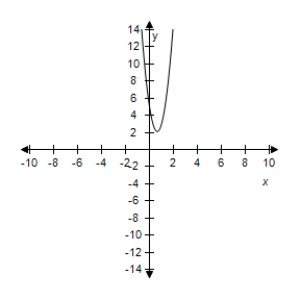
B)
C)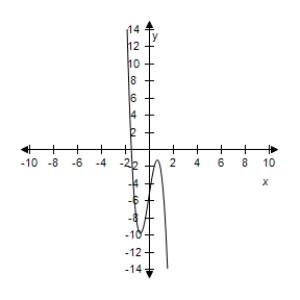
D)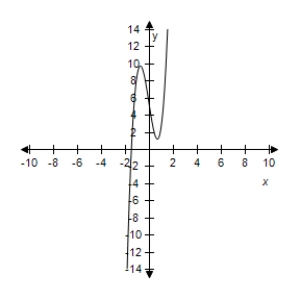
E)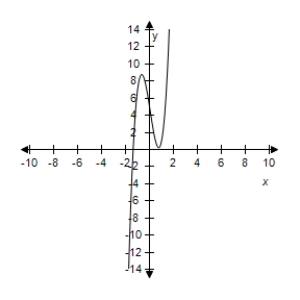
A)

B)

C)

D)

E)


Unlock Deck
Unlock for access to all 76 flashcards in this deck.
Unlock Deck
k this deck
14
Use long division to divide.
A)4
B)2
C)-2
D)1
E)3
A)4
B)2
C)-2
D)1
E)3

Unlock Deck
Unlock for access to all 76 flashcards in this deck.
Unlock Deck
k this deck
15
Select the correct graph of the following function.
A)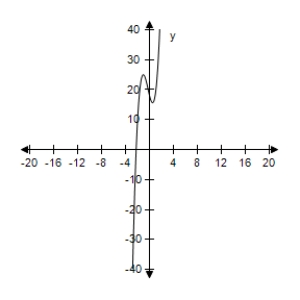
B)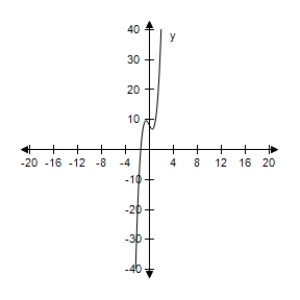
C)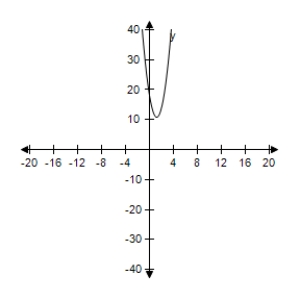
D)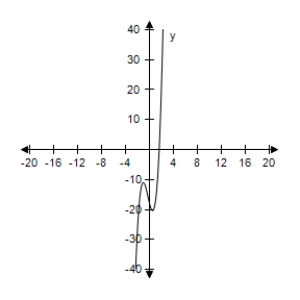
E)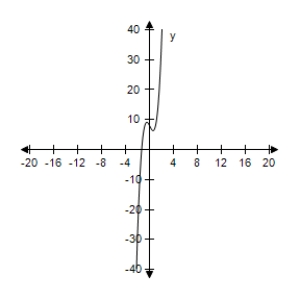
A)

B)

C)

D)

E)


Unlock Deck
Unlock for access to all 76 flashcards in this deck.
Unlock Deck
k this deck
16
The amounts A (in billions of dollars)donated to support higher education in the United States from 2000 through 2007 are shown in the table,where t represents the year,with t = 0 corresponding to 2000.
Use a graphing utility to create a scatter plot of the data.
A)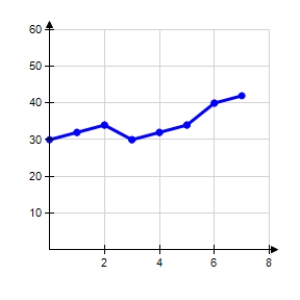
B)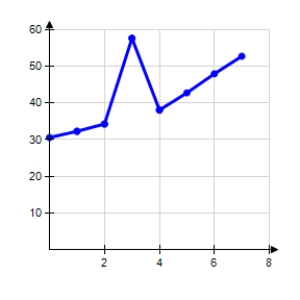
C)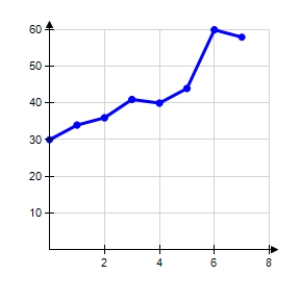
D)
E)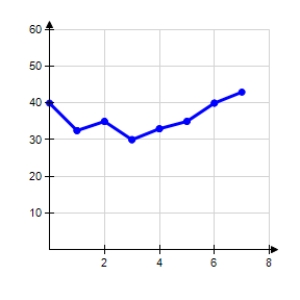
Use a graphing utility to create a scatter plot of the data.
A)

B)

C)

D)

E)


Unlock Deck
Unlock for access to all 76 flashcards in this deck.
Unlock Deck
k this deck
17
Use the Remainder Theorem and synthetic division to find the function value.
A)4.00
B)1.00
C)-1.00
D)6.00
E)5
A)4.00
B)1.00
C)-1.00
D)6.00
E)5

Unlock Deck
Unlock for access to all 76 flashcards in this deck.
Unlock Deck
k this deck
18
Use synthetic division to divide.
A)
B)
C)
D)
E)
A)
B)
C)
D)
E)

Unlock Deck
Unlock for access to all 76 flashcards in this deck.
Unlock Deck
k this deck
19
Find the value of k such that
X - 6 is a factor of x3 - kx2 + 2kx - 24.
A)k = 6
B)k = 10
C)k = 8
D)k = 7
E)k = 9
X - 6 is a factor of x3 - kx2 + 2kx - 24.
A)k = 6
B)k = 10
C)k = 8
D)k = 7
E)k = 9

Unlock Deck
Unlock for access to all 76 flashcards in this deck.
Unlock Deck
k this deck
20
Select the correct graph of the following function.
A)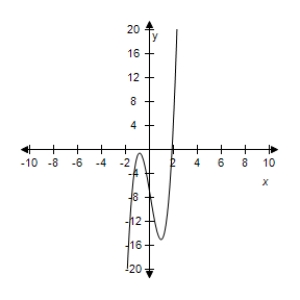
B)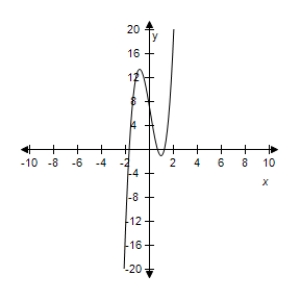
C)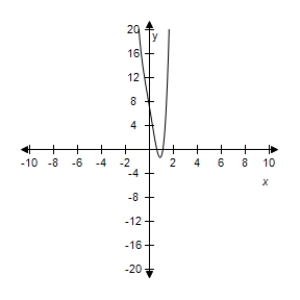
D)
E)
A)

B)

C)

D)

E)


Unlock Deck
Unlock for access to all 76 flashcards in this deck.
Unlock Deck
k this deck
21
Use the Remainder Theorem and synthetic division to find the function value.Verify your answer using another method.
A)94
B)-94
C)-90
D)-91
E)-89
A)94
B)-94
C)-90
D)-91
E)-89

Unlock Deck
Unlock for access to all 76 flashcards in this deck.
Unlock Deck
k this deck
22
Use synthetic division to divide.
A)
B)
C)
D)
E)
A)
B)
C)
D)
E)

Unlock Deck
Unlock for access to all 76 flashcards in this deck.
Unlock Deck
k this deck
23
Use the Remainder Theorem and synthetic division to find the function value.Verify your answer using another method.
A)2,070
B)2,065
C)2,068
D)-2,065
E)2,069
A)2,070
B)2,065
C)2,068
D)-2,065
E)2,069

Unlock Deck
Unlock for access to all 76 flashcards in this deck.
Unlock Deck
k this deck
24
Use the Remainder Theorem and synthetic division to find the function value.Verify your answer using another method.
A)11,141
B)11,140
C)11,139
D)11,136
E)-11,136
A)11,141
B)11,140
C)11,139
D)11,136
E)-11,136

Unlock Deck
Unlock for access to all 76 flashcards in this deck.
Unlock Deck
k this deck
25
Simplify the rational expression, ,by using long division or synthetic division.
A)
B)
C)
D)
E)
A)
B)
C)
D)
E)

Unlock Deck
Unlock for access to all 76 flashcards in this deck.
Unlock Deck
k this deck
26
Use long division to divide.
A)
B)
C)
D)
E)
A)
B)
C)
D)
E)

Unlock Deck
Unlock for access to all 76 flashcards in this deck.
Unlock Deck
k this deck
27
Using the factors (x - 4)and (x + 2),find the remaining factor(s)of and write the polynomial in fully factored form.
A)
B)
C)
D)
E)
A)
B)
C)
D)
E)

Unlock Deck
Unlock for access to all 76 flashcards in this deck.
Unlock Deck
k this deck
28
If is a root of ,use synthetic division to factor the polynomial completely and list all real solutions of the equation.
A)
B)
C)
D)
E)
A)
B)
C)
D)
E)

Unlock Deck
Unlock for access to all 76 flashcards in this deck.
Unlock Deck
k this deck
29
Use the zero or root feature of a graphing utility to approximate the zeros of accurate to the nearest thousandth.
A)x = -8.492,-0.695,1.186
B)x = -4.692
C)x = -3.575
D)x = -3.910,-0.763,1.173
E)x = -4.388,-0.720,1.108
A)x = -8.492,-0.695,1.186
B)x = -4.692
C)x = -3.575
D)x = -3.910,-0.763,1.173
E)x = -4.388,-0.720,1.108

Unlock Deck
Unlock for access to all 76 flashcards in this deck.
Unlock Deck
k this deck
30
Simplify the rational expression, ,by using long division or synthetic division.
A)
B)
C)
D)
E)
A)
B)
C)
D)
E)

Unlock Deck
Unlock for access to all 76 flashcards in this deck.
Unlock Deck
k this deck
31
Use the Remainder Theorem and synthetic division to find the function value.Verify your answer using another method.
A)3
B)4
C)2
D)-1
E)0
A)3
B)4
C)2
D)-1
E)0

Unlock Deck
Unlock for access to all 76 flashcards in this deck.
Unlock Deck
k this deck
32
Write the function in the form f(x)= (x - k)q(x)+ r for the given value of k and demonstrate that f(k)= r.
A)
B)
C)
D)
E)
A)
B)
C)
D)
E)

Unlock Deck
Unlock for access to all 76 flashcards in this deck.
Unlock Deck
k this deck
33
Use synthetic division to divide.
A)
B)
C)
D)
E)
A)
B)
C)
D)
E)

Unlock Deck
Unlock for access to all 76 flashcards in this deck.
Unlock Deck
k this deck
34
Use the Remainder Theorem and synthetic division to find the function value.Verify your answer using another method.
A)-18
B)-17
C)-21
D)-15
E)-19
A)-18
B)-17
C)-21
D)-15
E)-19

Unlock Deck
Unlock for access to all 76 flashcards in this deck.
Unlock Deck
k this deck
35
Use long division to divide.
A)
B)
C)
D)
E)
A)
B)
C)
D)
E)

Unlock Deck
Unlock for access to all 76 flashcards in this deck.
Unlock Deck
k this deck
36
Use synthetic division to divide.
A)
B)
C)
D)
E)
A)
B)
C)
D)
E)

Unlock Deck
Unlock for access to all 76 flashcards in this deck.
Unlock Deck
k this deck
37
If x = is a root of ,use synthetic division to factor the polynomial completely and list all real solutions of the equation.
A) ;x = ,2
B) ;x = ,2
C) ;x = ,2
D) ;x = ,2
E) ;x = , ,2
A) ;x = ,2
B) ;x = ,2
C) ;x = ,2
D) ;x = ,2
E) ;x = , ,2

Unlock Deck
Unlock for access to all 76 flashcards in this deck.
Unlock Deck
k this deck
38
Using the factors (5x + 4)and (x - 1),find the remaining factor(s)of and write the polynomial in fully factored form.
A)
B)
C)
D)
E)
A)
B)
C)
D)
E)

Unlock Deck
Unlock for access to all 76 flashcards in this deck.
Unlock Deck
k this deck
39
Use long division to divide.
A)
B)
C)
D)
E)
A)
B)
C)
D)
E)

Unlock Deck
Unlock for access to all 76 flashcards in this deck.
Unlock Deck
k this deck
40
Use the Remainder Theorem and synthetic division to find the function value.Verify your answer using another method.
A)-30
B)30
C)32
D)27
E)31
A)-30
B)30
C)32
D)27
E)31

Unlock Deck
Unlock for access to all 76 flashcards in this deck.
Unlock Deck
k this deck
41
Use synthetic division to divide.
A)
B)
C)
D)
E)
A)
B)
C)
D)
E)

Unlock Deck
Unlock for access to all 76 flashcards in this deck.
Unlock Deck
k this deck
42
Use the Remainder Theorem and synthetic division to find each function value.Verify your answers using another method.
A)-1,237
B)-1,231
C)-1,234
D)-1,235
E)-1,233
A)-1,237
B)-1,231
C)-1,234
D)-1,235
E)-1,233

Unlock Deck
Unlock for access to all 76 flashcards in this deck.
Unlock Deck
k this deck
43
Use synthetic division to perform the division.
A)
B)
C)
D)
E)none of these
A)
B)
C)
D)
E)none of these

Unlock Deck
Unlock for access to all 76 flashcards in this deck.
Unlock Deck
k this deck
44
Use long division to divide.
A)
B)
C)
D)
E)
A)
B)
C)
D)
E)

Unlock Deck
Unlock for access to all 76 flashcards in this deck.
Unlock Deck
k this deck
45
If x = -2 is a root of ,use synthetic division to factor the polynomial completely and list all real solutions of the equation.
A)
B)
C)
D)
E)
A)
B)
C)
D)
E)

Unlock Deck
Unlock for access to all 76 flashcards in this deck.
Unlock Deck
k this deck
46
Let .
Use synthetic division to find the value P (-6).
A)-2,608
B)-1,303
C)-1,305
D)-1,304
E)none of these
Use synthetic division to find the value P (-6).
A)-2,608
B)-1,303
C)-1,305
D)-1,304
E)none of these

Unlock Deck
Unlock for access to all 76 flashcards in this deck.
Unlock Deck
k this deck
47
Use synthetic division to divide.
A)
B)
C)
D)
E)
A)
B)
C)
D)
E)

Unlock Deck
Unlock for access to all 76 flashcards in this deck.
Unlock Deck
k this deck
48
Use long division to divide.
A)
B)
C)
D)
E)
A)
B)
C)
D)
E)

Unlock Deck
Unlock for access to all 76 flashcards in this deck.
Unlock Deck
k this deck
49
Use long division to divide.
A)
B)
C)
D)
E)
A)
B)
C)
D)
E)

Unlock Deck
Unlock for access to all 76 flashcards in this deck.
Unlock Deck
k this deck
50
Using the factors (x - 5)and (x + 2),find the remaining factor(s)of and write the polynomial in fully factored form.
A)
B)
C)
D)
E)
A)
B)
C)
D)
E)

Unlock Deck
Unlock for access to all 76 flashcards in this deck.
Unlock Deck
k this deck
51
Use synthetic division to express in the form (divisor)(quotient)+ remainder for the divisor x - 5.
A)
B)
C)
D)
E)none of these
A)
B)
C)
D)
E)none of these

Unlock Deck
Unlock for access to all 76 flashcards in this deck.
Unlock Deck
k this deck
52
Use synthetic division to divide.
A)
B)
C)
D)
E)
A)
B)
C)
D)
E)

Unlock Deck
Unlock for access to all 76 flashcards in this deck.
Unlock Deck
k this deck
53
Use synthetic division to express in the form (divisor)(quotient)+ remainder for the divisor x + 5.
A)
B)
C)
D)
E)none of these
A)
B)
C)
D)
E)none of these

Unlock Deck
Unlock for access to all 76 flashcards in this deck.
Unlock Deck
k this deck
54
Write in the form f (x)= (x - k)q(x)when k = -3.
A)
B)
C)
D)
E)
A)
B)
C)
D)
E)

Unlock Deck
Unlock for access to all 76 flashcards in this deck.
Unlock Deck
k this deck
55
If x = is a root of ,use synthetic division to factor the polynomial completely and list all real solutions of the equation.
A) x = , ,3
B) x = ,3
C) x = ,3
D) x = ,3
E) x = ,3
A) x = , ,3
B) x = ,3
C) x = ,3
D) x = ,3
E) x = ,3

Unlock Deck
Unlock for access to all 76 flashcards in this deck.
Unlock Deck
k this deck
56
Use long division to divide.
A)
B)
C)
D)
E)
A)
B)
C)
D)
E)

Unlock Deck
Unlock for access to all 76 flashcards in this deck.
Unlock Deck
k this deck
57
Use synthetic division to divide.
A)
B)
C)
D)
E)
A)
B)
C)
D)
E)

Unlock Deck
Unlock for access to all 76 flashcards in this deck.
Unlock Deck
k this deck
58
Use synthetic division to divide.
A)
B)
C)
D)
E)
A)
B)
C)
D)
E)

Unlock Deck
Unlock for access to all 76 flashcards in this deck.
Unlock Deck
k this deck
59
Use long division to divide.
A)
B)
C)
D)
E)
A)
B)
C)
D)
E)

Unlock Deck
Unlock for access to all 76 flashcards in this deck.
Unlock Deck
k this deck
60
Use synthetic division to divide.
A)
B)
C)
D)
E)
A)
B)
C)
D)
E)

Unlock Deck
Unlock for access to all 76 flashcards in this deck.
Unlock Deck
k this deck
61
Find all the rational zeros of the function .
A)x = -2,2,1,3
B)x = 3,1
C)x = -2,-1,-3
D)x = -1,-2
E)x = -2,2,-1,1,-3
A)x = -2,2,1,3
B)x = 3,1
C)x = -2,-1,-3
D)x = -1,-2
E)x = -2,2,-1,1,-3

Unlock Deck
Unlock for access to all 76 flashcards in this deck.
Unlock Deck
k this deck
62
Find all rational roots of the equation.
147x 3 - 98x 2 + 27x - 18 = 0
A)
B)
C)
D)
147x 3 - 98x 2 + 27x - 18 = 0
A)
B)
C)
D)

Unlock Deck
Unlock for access to all 76 flashcards in this deck.
Unlock Deck
k this deck
63
The number (1 + i)is a root of the equation.
X 3 - 10x 2 + 18x - 16 = 0
Find the other roots of the equation.
A)x = 1 - i
B)x = 1 + i
C)x = 5
D)x = 8
X 3 - 10x 2 + 18x - 16 = 0
Find the other roots of the equation.
A)x = 1 - i
B)x = 1 + i
C)x = 5
D)x = 8

Unlock Deck
Unlock for access to all 76 flashcards in this deck.
Unlock Deck
k this deck
64
Use synthetic division to divide. 


Unlock Deck
Unlock for access to all 76 flashcards in this deck.
Unlock Deck
k this deck
65
Use synthetic division to perform the division. 


Unlock Deck
Unlock for access to all 76 flashcards in this deck.
Unlock Deck
k this deck
66
Use synthetic division to perform the division.
A)
B)
C)
D)
E)none of these
A)
B)
C)
D)
E)none of these

Unlock Deck
Unlock for access to all 76 flashcards in this deck.
Unlock Deck
k this deck
67
Find all real zeros of the polynomial and determine the multiplicity of each.
A)x = 49,multiplicity 2;x = 64,multiplicity 2
B)x = 7,multiplicity 2;x = 8,multiplicity 2
C)x = 49,multiplicity 2;x = 8,multiplicity 1
D)x = -7,multiplicity 2;x = -8,multiplicity 2
E)x = 7,multiplicity 1;x = -7,multiplicity 1;x = 8,multiplicity 1;x = -8,multiplicity 1
A)x = 49,multiplicity 2;x = 64,multiplicity 2
B)x = 7,multiplicity 2;x = 8,multiplicity 2
C)x = 49,multiplicity 2;x = 8,multiplicity 1
D)x = -7,multiplicity 2;x = -8,multiplicity 2
E)x = 7,multiplicity 1;x = -7,multiplicity 1;x = 8,multiplicity 1;x = -8,multiplicity 1

Unlock Deck
Unlock for access to all 76 flashcards in this deck.
Unlock Deck
k this deck
68
Use the zero or root feature of a graphing utility to approximate the zeros of accurate to the nearest thousandth.
A)x = -4.692
B)x = -8.492,-0.695,1.186
C)x = -3.575
D)x = -4.388,-0.720,1.108
E)x = -3.910,-0.763,1.173
A)x = -4.692
B)x = -8.492,-0.695,1.186
C)x = -3.575
D)x = -4.388,-0.720,1.108
E)x = -3.910,-0.763,1.173

Unlock Deck
Unlock for access to all 76 flashcards in this deck.
Unlock Deck
k this deck
69
Use Descartes' rule of signs to find the number of possible positive,negative,and nonreal roots for the following equation. 4x 7 + 9x 2 + 5x + 10 = 0
A)0 positive;1 negative;6 nonreal
B)2 positive;1 or 3 negative;4 or 0 nonreal
C)0 positive;0 negative;7 nonreal
D)0 positive;0 or 2 negative;5 or 7 nonreal
E)none of these
A)0 positive;1 negative;6 nonreal
B)2 positive;1 or 3 negative;4 or 0 nonreal
C)0 positive;0 negative;7 nonreal
D)0 positive;0 or 2 negative;5 or 7 nonreal
E)none of these

Unlock Deck
Unlock for access to all 76 flashcards in this deck.
Unlock Deck
k this deck
70
Let  .
.
Use synthetic division to find the value P (-7).
 .
.
Use synthetic division to find the value P (-7).

Unlock Deck
Unlock for access to all 76 flashcards in this deck.
Unlock Deck
k this deck
71
Find all rational roots of the equation.
13x 3 - 2x 2 + 52x - 8 = 0
A)
B)x = -2i
C)x = 2i
D)
E)
13x 3 - 2x 2 + 52x - 8 = 0
A)
B)x = -2i
C)x = 2i
D)
E)

Unlock Deck
Unlock for access to all 76 flashcards in this deck.
Unlock Deck
k this deck
72
Find all the real zeros of .
A)x = 3,
B)x = 2,1,-6
C)x = ± 1,3
D)x = 3
E)x = ,
A)x = 3,
B)x = 2,1,-6
C)x = ± 1,3
D)x = 3
E)x = ,

Unlock Deck
Unlock for access to all 76 flashcards in this deck.
Unlock Deck
k this deck
73
Find all the rational zeros of the function .
A)x = 1,-5,5,-2
B)x = -2,-5,-5
C)x = -1,-5,5,
D)x = , , ,5
E)x = -2,-5, ,
A)x = 1,-5,5,-2
B)x = -2,-5,-5
C)x = -1,-5,5,
D)x = , , ,5
E)x = -2,-5, ,

Unlock Deck
Unlock for access to all 76 flashcards in this deck.
Unlock Deck
k this deck
74
Use Descartes' Rule of Signs to determine the possible number of positive and negative zeros of .
A)3 positive reals or 1 positive real;3 negative reals or 1 negative real
B)3 positive reals or 1 positive real;no negative reals
C)0 positive real;3 negative reals or 1 negative real
D)1 positive real;3 negative reals or 1 negative real
E)no positive reals;no negative reals
A)3 positive reals or 1 positive real;3 negative reals or 1 negative real
B)3 positive reals or 1 positive real;no negative reals
C)0 positive real;3 negative reals or 1 negative real
D)1 positive real;3 negative reals or 1 negative real
E)no positive reals;no negative reals

Unlock Deck
Unlock for access to all 76 flashcards in this deck.
Unlock Deck
k this deck
75
Use Descartes' Rule of Signs to determine the possible number of positive and negative zeros of .
A)3 positive reals or 1 positive real;3 negative reals or 1 negative real
B)3 positive reals or 1 positive real;no negative reals
C)1 positive real;3 negative reals or 1 negative real
D)3 positive reals or 1 positive real;1 negative real
E)no positive reals;no negative reals
A)3 positive reals or 1 positive real;3 negative reals or 1 negative real
B)3 positive reals or 1 positive real;no negative reals
C)1 positive real;3 negative reals or 1 negative real
D)3 positive reals or 1 positive real;1 negative real
E)no positive reals;no negative reals

Unlock Deck
Unlock for access to all 76 flashcards in this deck.
Unlock Deck
k this deck
76
Find all the real zeros of .
A)x = ,4
B)x = ,
C)x = ,-2
D)x = ,
E)x = ,-4
A)x = ,4
B)x = ,
C)x = ,-2
D)x = ,
E)x = ,-4

Unlock Deck
Unlock for access to all 76 flashcards in this deck.
Unlock Deck
k this deck



